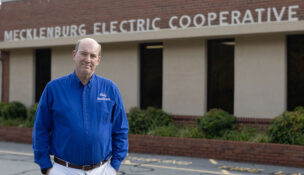Dominion plans more natural gas, solar in 20-year forecast
Nonbinding plan would slow down battery storage
Kate Andrews //October 30, 2025//

Dominion Energy brought this Gloucester County solar farm online in 2019 to provide renewable energy offsets for Meta Platforms’ Facebook. It generates enough power for 5,000 homes at peak output. Photo courtesy Dominion Energy

Dominion Energy brought this Gloucester County solar farm online in 2019 to provide renewable energy offsets for Meta Platforms’ Facebook. It generates enough power for 5,000 homes at peak output. Photo courtesy Dominion Energy
Dominion plans more natural gas, solar in 20-year forecast
Nonbinding plan would slow down battery storage
Kate Andrews //October 30, 2025//
Summary:
- Dominion Energy has submitted an update to its 2024 integrated resource plan
- New plan calls for 40% more natural gas to 2045 compared to 2024 IRP’s estimate
- Solar power will make up about half of all new power generated
Virginia’s future could hold more solar and natural gas power generation, according to an integrated resource plan filed by Dominion Energy this month.
Filed Oct. 15 with the Virginia State Corporation Commission, the nonbinding energy production outlook anticipates about 5% annual increase in energy demand over the next 20 years, which would double the state’s demand by 2045. The report also takes into consideration the Virginia Clean Economy Act‘s requirement that Dominion shift to carbon-free, renewable energy sources for electricity generation by 2045.
The new plan is an update on last year’s IRP, which called for more offshore wind and solar energy development, as well as the development of small modular nuclear reactors that could be active in the 2030s.
The utility set out three separate scenarios in the 250-page document, although only two are viewed by Dominion as viable options:
- The company-preferred plan, in which solar, wind and battery storage would make up 54% of Dominion’s capacity mix in 2045; gas and steam would make up 33%, and nuclear energy, 8%;
- The lowest-cost VCEA-compliant plan without Environmental Protection Agency regulations, in which renewable energy would make up 54% of capacity mix; gas, 29%; nuclear, 7%;
- The “forced retirements by 2045” plan would lead to 78% renewable energy capacity, 14% nuclear and 4% gas and steam — however, Dominion’s analysis says “the company does not see a viable path towards full retirement of all carbon-emitting resources by 2045.”
The utility also anticipates construction costs for the three plans in the report: $270.4 billion for the “forced retirements” plan; $91.8 billion for the company’s preferred plan; $80.1 billion for the lowest-cost VCEA-compliant plan without EPA regulations. The “forced retirement” plan calls for doubling the number of large-scale nuclear plants and SMRs, contributing to its overall cost, but the 2025 IRP says that this plan is not considered feasible because of customer affordability concerns, capital costs and reliability issues.
According to Dominion spokesperson Tim Eberly, the major — and feasible — changes from the 2024 IRP are a 40% increase in natural gas generation the utility expects to need over the next 20 years, and a reduction in the amount of battery storage. Also, more than half of the utility’s new power generation is expected to be solar.
Although solar and energy storage plants are viewed as operating hand in hand, Eberly explained that power storage is still a relatively young technology. Lithium-ion batteries store power for only four to six hours, and Dominion and other utilities need to be able to store energy over a much longer period of time since solar- and wind-powered generation is intermittent.
To meet future demand for energy, Eberly added, the utility expects it will have to provide about 33 gigawatts of new power over the next 20 years under the company-preferred plan. This will help meet demand produced by the growing data center industry as well as lower Dominion’s purchase of energy produced by third-party sources. Currently about 20% of all Dominion’s power comes from outside sources, and the utility’s goal is to lower that to 4% by 2045.
Natural gas plants are a point of contention for many environmentalists and concerned neighbors, but Dominion officials and others in Virginia view the plants as necessary backup options for peak energy hours if not enough solar and wind energy is being produced to keep the lights on. Under the VCEA, there is a loophole that allows natural gas to be used as a backup energy producer with state approval, but Gov. Glenn Youngkin and other Republicans have suggested that the VCEA needs to be changed to allow more natural gas plants to operate past 2045.
Eberly said, however, that the October IRP does not anticipate or project changes to the law, which was passed in 2020, before artificial intelligence and increased home internet use led to much higher energy demands.
Despite all of the calculations, the IRP is just a forecast for Dominion’s coverage region of Virginia and North Carolina, and the region’s energy needs for the next two decades. A second document, Dominion’s sixth annual clean energy report filed with the SCC in October, delineates solar and energy storage projects already approved by localities but waiting for the SCC’s green light. These annual reports are required under the VCEA.
Forthcoming projects in the report include 11 solar and energy storage facilities statewide that would produce 1,400 megawatts of electricity, enough to power 3,500 homes, Eberly said, noting that most of these projects are set to be in operation between 2027 to 2030. Eight are large-scale projects, and more than 1,000 megawatts will be produced by Dominion-owned facilities. The remaining 400 megawatts will come from third-party power purchase agreements, he said. Eberly estimates that the construction of these projects will add about $3.20 to the typical customer’s monthly power bill.
As for concerns about massive data centers prompting higher residential power bills, Eberly said that Dominion is trying to create a customer class just for data centers, an effort to protect residential customers’ wallets.
l
















